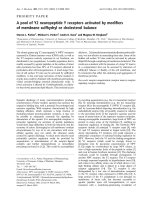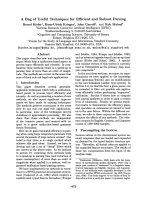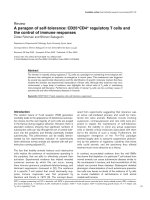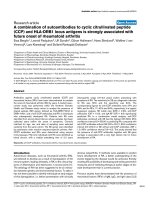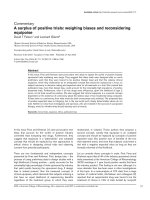Báo cáo y học: "A surplus of positive trials: weighing biases and reconsidering equipoise" ppt
Bạn đang xem bản rút gọn của tài liệu. Xem và tải ngay bản đầy đủ của tài liệu tại đây (36.18 KB, 3 trang )
117
ACR = American College of Rheumatology; HA = hyaluronic acid; RCT = randomized controlled trial.
Available online />In this issue Fries and Krishnan [1] raise provocative new
ideas that account for the surfeit of positive industry
controlled trials evaluating new drugs. Furthermore, they
suggest that equipoise is a ‘paternalistic’ and outdated
concept that should be replaced by new approaches to
ethical choice in designing clinical trials and obtaining
consent from potential participants.
There are two fundamental and independent concepts
presented by Fries and Krishnan. First, design bias – the
process of using preliminary data to design studies with a
high likelihood of being positive – partly accounts for the
remarkably high percentage of trials sponsored by industry
that yield results favoring the sponsored drug. If design
bias is indeed present, then the treasured concept of
clinical equipoise, which demands that subjects entering a
trial have an equal likelihood of experiencing benefits
regardless of the treatment group to which they were
randomized, is violated. Those authors then propose a
second concept, namely that equipoise is an outdated
concept and should be replaced by concepts of positive
expected value (the positive sum of benefits of the two
trial treatment arms), and even that subjects could enter a
trial with a negative expected value as long as they are
honestly informed of this likelihood.
Let us consider these concepts in order. First, Fries and
Krishnan report that all 45 of the industry sponsored clinical
trials presented at the American College of Rheumatology
(ACR) meetings in 1 year found positive results that favor
the industry product. This finding is not new, although it is
more dramatic than has been seen in other investigations
of this topic. In a meta-analysis of 370 trials from a large
number of medical fields, Als-Nielsen and colleagues [2]
reported that an experimental drug was found to be the
treatment of choice in 16% of trials funded by nonprofit
Commentary
A surplus of positive trials: weighing biases and reconsidering
equipoise
David T Felson
1
and Leonard Glantz
2
1
Boston University School of Medicine, Boston, Massachusetts, USA
2
Boston University School of Public Health, Boston, Massachusetts, USA
Corresponding author: David Felson (e-mail: )
Received: 5 Apr 2004 Accepted: 15 Apr 2004 Published: 27 Apr 2004
Arthritis Res Ther 2004, 6:117-119 (DOI 10.1186/ar1189)
© 2004 BioMed Central Ltd
Abstract
In this issue, Fries and Krishnan raise provocative new ideas to explain the surfeit of positive industry
sponsored trials evaluating new drugs. They suggest that these trials were designed after so much
preliminary work that they were bound to be positive (design bias) and that this violates clinical
equipoise, which they characterize as an antiquated concept that should be replaced by a focus on
subject autonomy in decision making and expected value for all treatments in a trial. We contend that
publication bias, more than design bias, could account for the remarkably high prevalence of positive
presented trials. Furthermore, even if all new drugs were efficacious, given the likelihood of type 2
errors, not all trials would be positive. We also suggest that clinical equipoise is a nuanced concept
dependent on the existence of controversy about the relative value of two treatments being compared.
If there were no controversy, then trials would be both unnecessary and unethical. The proposed idea
of positive expected value is intriguing, but in the real world such clearly determinable values do not
exist. Neither is it clear how investigators and sponsors, who are invested in the success of a proposed
therapy, would (or whether they should) develop such a formula.
Keywords: clinical trials, equipoise, ethics, publication bias
118
Arthritis Research & Therapy Vol 6 No 3 Felson and Glantz
organizations, in 30% of trials not reporting funding, and in
51% of trials funded by for-profit organizations (difference
P < 0.001). Indeed, the tendency of published industry
sponsored trials to have positive results that favor the
experimental drug has even been seen in arthritis trials. In
a study that focused on trials evaluating the efficacy of
nonsteroidal anti-inflammatory drugs, Rochon and
colleagues [3] reported that industry sponsors were likely
to publish results favoring their own drug.
We agree with all of the possible explanations provided by
Fries and Krishnan, although we disagree with the
potential magnitude of the biases discussed. For example,
it was suggested that publication bias (i.e. the tendency
for null studies, especially small ones, not to be published)
was not a large enough problem to account for this bias
toward publication of positive trials. Fries and Krishnan
cite a number of sources that presumably attest to the
relatively low impact of publication bias; however, our
review of these references suggests that, although they
are valuable publications that explore the origins of
publication bias, they provide no evidence on the
supposed small effect of publication bias. Indeed, much
evidence is to the contrary. The initial article describing
publication bias emanated from a study of ovarian cancer
chemotherapy [4], in which it was documented that the
presence of publication bias was sufficient to make
ovarian cancer chemotherapy appear life saving when a
comprehensive evaluation of published and unpublished
trials failed to show any significant life-saving effect. Villar
and colleagues [5] recently conducted a study in which
the results of a meta-analysis evaluating the efficacy of a
therapy were compared with those of a subsequent large
definitive clinical trial of the same therapy. Those
investigators suggested that the most prominent reason
for discordance between clinical trial and meta-analysis
results was publication bias in the meta-analysis. They
recommended that a formal evaluation of publication bias
be included in every meta-analysis so that the results will
not ‘mislead’.
Similarly, in arthritis trials, publication bias has been of
sufficient magnitude to account for all of the reported
efficacy of drugs in published studies. For example, in a
meta-analysis of glucosamine and chondroitin, McAlindon
and colleagues [6] reported that both neutraceuticals
appear to have positive effects in randomized trials, but
that publication bias limited definitive conclusions. Almost
all of the trials included in that meta-analysis were industry
funded. After publication of the meta-analysis, a large
publicly funded multicenter Canadian trial of glucosamine
was presented, which showed no efficacy of glucosamine,
suggesting again that industry sponsorship and
publication bias may account for the entire apparent effect
of a therapy. In a more recent meta-analysis, Lo and
colleagues [7] evaluated hyaluronic acid (HA) injections
for the treatment of knee osteoarthritis, and reported the
existence of publication bias that could have accounted
for the entire treatment effect. Furthermore, that meta-
analysis of osteoarthritis reported that there were three
randomized trials evaluating a large molecular weight HA
preparation; the two trials sponsored by the manufacturer
of the preparation yielded remarkably positive results, but
the one trial in which that particular preparation was a
comparator against another active HA compound reported
that the large molecular weight compound had absolutely
no efficacy. Thus, industry sponsorship can determine the
magnitude of the efficacy reported in published findings,
and publication bias can account for all of the efficacy
seen in published reports.
Publication bias originates primarily with the investigators,
and sponsors performing trials who decide whether to
submit their trial for publication. Studies suggest that it
does not arise with journal editors, who are often willing to
publish reports of null trials [8,9].
Fries and Krishnan [1] postulate that an important reason
for the positive results reported in industry sponsored
trials is ‘design bias’. The contention is that, given the
extensive preliminary work and scientific investment in the
development of a new therapy, including preliminary trials
to evaluate efficacy, it stands to reason that most trials
evaluating such a therapy will be positive. This argument
ignores the possibility that, even when a treatment is
efficacious, there may be type 2 errors (i.e. failure to find
efficacy of a treatment even when it is efficacious). The
likelihood of a type 2 error is directly correlated with the
power of a study. In a series of studies of an efficacious
agent, each with 80% power, 20% of the trials would
show no significant efficacy. That all of 45 trials reported
efficacy of the sponsored therapy, as indicated by Fries
and Krishnan, is nearly statistically impossible, given the
certainty of occasional type 2 errors.
One wonders whether all 45 trials presented as ‘positive’
actually had unequivocally positive results. The testing of
multiple outcomes in multiple different analyses can
ultimately produce a positive result when a predefined
analytic approach to a single outcome measure does not.
Furthermore, subset analyses can show positive results
when a main effect is negative.
Another explanation for design bias relates to the choice
of comparator. Both Rochon and coworkers [3] and Lo
and colleagues [7] reported that a comparator drug is
often selected that is ‘easy to beat’ and, further, that the
comparator drug often performs worse with respect to
efficacy than it does in other trials.
Whether the trial is designed with a weak comparator or a
treatment is chosen that is nearly certain to be successful,
119
design bias may exist; if this is the case, then clinical
equipoise is absent. Fries and Krishnan [1] suggest that
this situation is acceptable and provide alternative ways of
conceptualizing the ethics of trial design that would
dispense with the need for clinical equipoise.
Clinical equipoise is not necessarily only present when, as
Fries and Krishnan suggest, there is a precisely equal
chance of benefit with both treatments in a trial. It is
present when there is a bona fide scientific or clinical
controversy that needs resolution, and that is ultimately
what is meant by clinical equipoise. Indeed, Freedman
[10], who is widely credited with coining the term, defines
it simply as the ‘state of uncertainty about the relative
merits of A and B’. This state of knowledge cannot be
determined by subjects. Before approaching subjects,
both researchers and institutional review boards must
determine that there is such a legitimate controversy or
question. If it is true that drug companies are accurate
essentially 100% of the time, then there would be no
controversy and therefore no justification for randomized
controlled trials (RCTs). Indeed, if there is virtual certainty
in the outcome of a clinical trial, then one might argue that
research conducted in human subjects would be
unethical. This is especially true in trials in which there is a
placebo arm. Would Fries and Krishnan agree?
What about the concept of positive expected value? In the
real world such clearly determinable values do not exist,
and neither is it clear how investigators and sponsors, who
are invested in the success of a proposed therapy, would
develop such a formula. It is noteworthy, however, that if
one buys this formula then it is the end of the development
of ‘me too’ drugs. It is also interesting to consider how this
would apply to drugs whose alleged benefits are that they
are longer acting or more convenient to administer. What
percentage would be attached to those advantages? The
formula also assumes that any positive value would
legitimate the research without considering that very
marginal positive values may not be without risk or
inconvenience to subjects.
Fries and Krishnan [1] propose that subject autonomy can
assume precedence and that subjects should be allowed
to choose to participate in a trial even if there is a negative
value of treatment. This places an almost absolute value
on autonomy and assumes that subject consent is the
determinative fact in research ethics. However, there are
values other than the autonomy of subjects that play a
role. For example, an essential issue is not what subjects
can consent to but what investigators can ethically ask
subjects to do.
Finally, Fries and Krishnan are concerned that RCTs are
the only available means by which subjects can gain
access to new and promising treatments. This statement
ignores the inherently coercive nature of this circum-
stance; the desperation of a potential subject does not
provide much justification for RCTs. Also, it is not access
to a ‘treatment’ that is at stake but rather possible access
to a possible treatment – a much attenuated ‘benefit’.
Ultimately, we believe that the high rate of positive industry
sponsored trials presented at the ACR meetings provides
an alert that either ethical problems in trial design exist or
that publication and other biases allow attendees at the
ACR meetings a selected glimpse of all informative trials
or a biased summary or interpretation of the trial’s
unvarnished results.
Competing interests
None declared.
References
1. Fries JF, Krishnan E: Equipoise, design bias, and randomized
controlled trials: the elusive ethics of drug development.
Arthritis Res Ther 2004, 6:R250-R255.
2. Als-Nielsen B, Chen W, Gluud C, Kjaergard LL: Association of
funding and conclusions in randomized drug trials. JAMA
2003, 290:921-928.
3. Rochon PA, Gurwitz JH, Simms RW, Fortin PR, Felson DT,
Minaker KL, Chalmers TC: A study of manufacturer supported
trials of non-steroidal anti-inflammatory drugs. Arch Intern
Med 1994, 54:157-163.
4. Begg CB, Berlin JA: Publication bias and dissemination of clin-
ical research. J Natl Cancer Inst 1989, 81:107-115.
5. Villar J, Piaggio G, Carroli G, Donner A: Factors affecting the
comparability of meta-analyses and largest trials results in
perinatology. J Clin Epidemiol 1997, 50:997-1002.
6. McAlindon TE, LaValley MP, Felson DT: Efficacy of glucosamine
and chondroitin for treatment of osteoarthritis. JAMA 2000,
284:1241-1242.
7. Lo GH, LaValley M, McAlindon T, Felson DT: Intraarticular
hyaluronic acid in treatment of knee osteoarthritis. A meta-
analysis. JAMA 2003, 290:3115-3121.
8. Dickersin K, Min YI, Meinert CL: Factors influencing publication
of research results. JAMA 1992, 267:374-378.
9. Olson CM, Rennie D, Cook D, Dickersin K, Flanagin A, Hogan
JW, Zhu Q, Reiling J, Pace B: Publication bias in editorial deci-
sion making. JAMA 2002, 287:2825-2828.
10. Freedman B: Equipoise and the ethics of clinical research. N
Engl J Med 1987, 317:141-145.
Available online />

